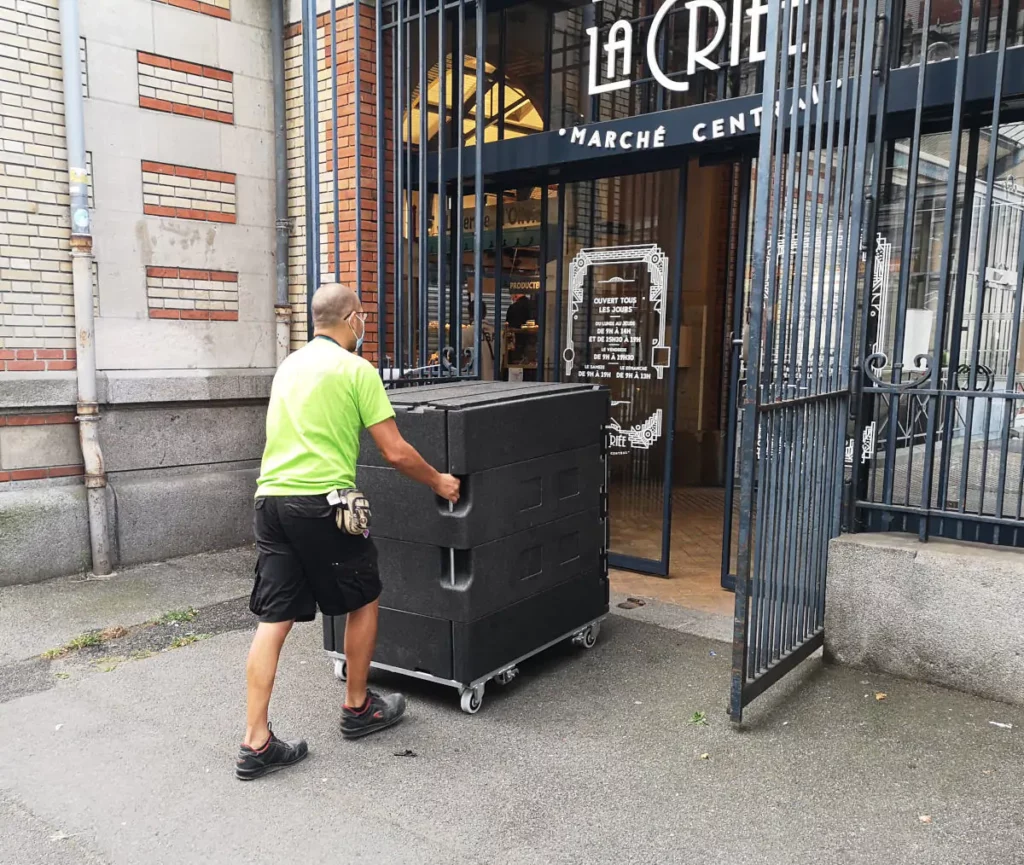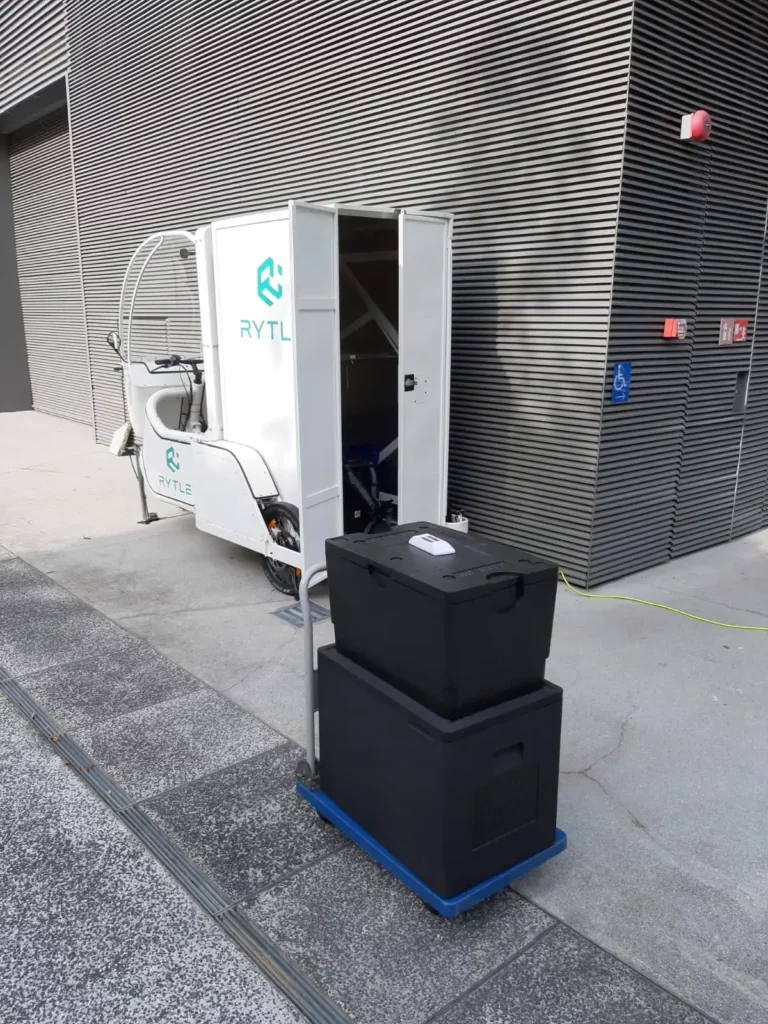Pro cycling logistics: a future model for urban logistics?
13 February 2025 by Edina GÁLFI

2021 will have been marked by the spotlight suddenly thrown on transport and logistics: distribution of COVID-19 vaccines, the general average of the Ever-Given, a 400-metre long container ship that got stuck in the Suez Canal, a shortage of lorry drivers, the blockages at Dover, and so on. And all in a year of lockdowns where the delivery of goods became a central issue.
This has all led to a rethink of the prevailing models of productivity and profitability of flows of goods with a view to optimising the links in the chain represented by the first and the last mile for environmental reasons and to reduce delivery times.
The entire supply chain is impacted: order preparation, storage, transport and delivery.
According to the definition of Roland Berger, a firm of consultants, “urban logistics encompasses all the physical flows and information flows allowing goods to be carried to their destination in or from metropolitan areas under the best possible conditions.”
2021 will also have been the year when people became aware of the collateral effects generated by urban deliveries and online food shopping (up 100% during the lockdown). Consumers are taking an ever greater interest in the origin and methods of production of the goods they buy, and this includes the delivery methods used. These must be green and sustainable as well as flexible and adaptable, taking urban traffic into account.
Today’s cities, largely populated with higher income groups with limited time, are serving as a testing ground for last-mile logistics and “ultra-local” urban delivery solutions. The objectives are twofold:
Combating noise pollution, drastically reducing air pollution and the need to reduce urban congestion are the issues currently guiding and hardening cities’ policies, and this is having a considerable impact on modes of delivery. The French “LOM” law (Mobility Orientation Law) passed in 2019 provides for a ban on the sale of petrol and diesel vehicles by 2040. Certain municipal authorities, such as Paris, have decided to become early movers in this field, opting to ban diesel vehicles from their roads from 2024, with a ban on petrol vehicles to follow by 2040.
Urban travel plans (PDUs) designed to relieve congestion in urban centres also impose regulations on city centre deliveries: restricted access to certain zones (low-emission zones), urban road tolls for freight vehicles, limiting deliveries to certain timeslots.
This is causing disruption to the logistics ecosystem, which now finds itself obliged to re-invent itself. It needs to introduce solutions that combine better productivity, profitability and environmental responsibility. So-called “soft” solutions using alternative energy sources: hydrogen, natural gas or electricity. Flexible solutions: use of smaller vehicles to facilitate last-mile logistics in urban settings.

Faced with the different environmental regulations that apply, carriers and logistics firms are having to rethink the logic of their supply chains, focusing on what are known as “short channels”. This then leads to a need to create supply structures, warehouses, in the urban centre themselves, as close as possible to the end consumer. However, they are faced with an onerous reality: the high cost of land, the difficulty in finding large enough spaces, transport flows that local populations see as a nuisance.
In the face of these difficulties relating to the real estate, different actors in the supply chain are organising to pool their skills and expertise. And so innovative types of logistics infrastructure are now seeing the light of day, such as La Chapelle Internationale in Paris: rail, road and warehousing facilities share the same site to distribute goods to central Paris. This type of multi-modal platform is spreading fast in Europe. The aim is to increase profitability by sharing the costs, gain flexibility and improve productivity by using small delivery vehicles that can complete several delivery rounds in one day and meet environmental requirements.
The transporting of foodstuffs is regulated by a special body, Cémafroid. It determines the conditions of transport and storage of foodstuffs according to type:
Each type of foodstuff is therefore subject to specific temperature requirements. Fresh foodstuffs must be kept at a temperature between +2°C and +4°C to ensure that food safety requirements are met for the end consumer. This is what is referred to as the cold chain. No break in the cold chain is allowed by law. Urban deliveries are of course no exception to this statutory requirement: the continuity of the cold chain is mandatory for all foodstuffs.
Finally, the transportation of perishable goods is a segment of the logistics market that is subject to specific regulations applied and disseminated by Cémafroid. The purpose of these regulations is to guarantee food safety and public health. According to Articles R.231-45 and R231-46 of the French Rural and Maritime Fishing Code “vehicles used to transport perishable foodstuffs must be of a category and class allowing them to meet the temperature requirements defined for different categories of foodstuffs throughout the duration of their transportation.” .
A certificate of conformity is therefore required, the ATP (Transport of Perishable Foodstuffs Certificate) for the temperature-controlled transportation of foodstuffs:
The certificates issued when you purchase your insulated vehicle are valid for 6 years. After that, the certificate must be renewed every 3 years.
The increase in online food shopping has raised multiple issues: the need to comply with the mobility laws, to be competitive in an ultra-competitive market (speed and low cost of delivery) whilst complying with all the applicable regulations.

Changes in urban policies – reduction of noise pollution and CO² emissions, smoothing traffic flows – will inevitably lead to the gradual disappearance of certain vehicles from low-emission zones. Refrigerated lorries will therefore be marginalised in low-emission zones – too noisy, difficult to convert to electric power – and they will probably be replaced by alternative hybrid vehicles. In the same context, soft temperature-controlled transport solutions are being structured, already offering sustainable, low-cost, recyclable insulated solutions. The insulated BOX and ROLL containers remain valid technologies that allow both temperature control and transport pooling – leading to cost savings, a reduced carbon footprint and more flexible urban goods flows. In other words, the winning trio for logistics operators who deliver foodstuffs.
